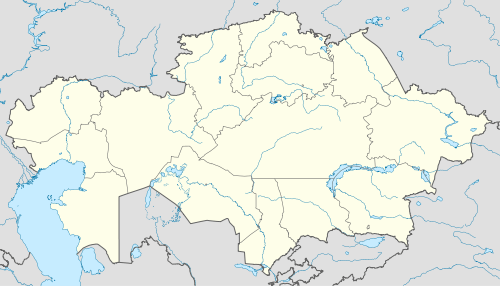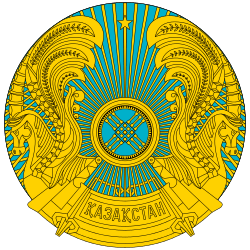Ridder, Kazakhstan
| Ridder Риддер | ||
|---|---|---|
| ||
 Ridder Location in Kazakhstan | ||
| Coordinates: 50°21′N 83°31′E / 50.350°N 83.517°ECoordinates: 50°21′N 83°31′E / 50.350°N 83.517°E | ||
| Country | Kazakhstan | |
| Province | East Kazakhstan Province | |
| Founded | May 31, 1786 | |
| Incorporated (city) | January 1, 1932 | |
| Government | ||
| • Akim (mayor) | Zhomart Muratov | |
| Elevation | 1,000 m (3,000 ft) | |
| Population (2009) | ||
| • Total | 50,500 | |
| Time zone | UTC+6 | |
| Area code(s) | +7 72336 | |
Ridder (Kazakh and Russian: Риддер), formerly known as Leninogorsk (Russian: Лениногорск, 1941–2002) is a city in the East Kazakhstan Province in north-eastern Kazakhstan. Population: 50,500 (2009 Census results).[1] The city is situated in the southwestern Altai Mountains and northeastern of the region's capital, Oskemen, along the Ulba River, at an elevation higher than 1,000 metres.[2]
History
The fact that Altai Krai is rich in natural deposits was recalled during Empress’ Catherine II ruling. The history of Ridder started in 1786 when 9 troops were sent to Altai to search natural deposits. One of the troops was headed by an officer Philip Ridder. On May 31, 1786, he found a very rich deposit containing gold, silver and other metals.[3]
The same year, in summer, the settlement was founded there and it was named Riddersky pit. This was how the city was founded. Unique ores of Riddersky deposit were marked by specialists of various levels and commissions. The deposit became known far beyond Russian Empire. In 1850, Riddersky ores received the highest appreciation at London World Exhibition, in 1879 the samples were included into the museum collection of Stockholm Royal Technical Institute.
In early 20th century Rudder experienced a number of foreign concessions, revolution and Civil war. On January 1, 1932, the settlement Riddersky became a town. Before World War II the town of Ridder was renamed into Leninogorsk.
During Soviet power industrial construction was growing in Leninogorsk. Several plants were constructed - lead plant was one of the first plants of non-ferrous industry in Kazakhstan, Leninogorsky cascade of hydro power stations was the only one in Kazakhstan and the second one in Soviet Union. Also several mines and factories, zinc plant were built. The college of mining and metallurgy was opened.
During World War II Leninogorsk produced about 50% of high-quality lead in the whole Soviet Union. In 2002 the city received its original name - Ridder.[4]
Economy
Ridder is a center of mining operations and processing of nonferrous metals. Other branches of industry include wood and textile industry, food production, and mechanical engineering.
Transport
The European route E40, originating in Calais, France, has its eastern terminus in Ridder. Over 8,000 kilometres (5,000 mi) long, it is the longest European route.
Ethnic Composition
- Russians — 49,630 (85.29%)
- Kazakhs — 5,731 (9.85%)
- Germans — 624 (1.07%)
- Tatars — 588 (1.01%)
- Ukrainians — 567 (0.97%)
Points of interest
Points of interest include a local museum and a botanical garden.
Sports
In March 2013, Ridder hosted the World Ski Orienteering Championships.
References
- ↑ "Население Республики Казахстан" (in Russian). Департамент социальной и демографической статистики. Retrieved 8 December 2013.
- ↑ "Ridder City, Kazakhstan". Britannica.com. Retrieved February 13, 2014.
- ↑ "Ridder City, Kazakhstan". AboutKazakhstan.com. Retrieved February 13, 2014.
- ↑ "Town of Leninogorsk, Kazakhstan to regain historic name - Ridder". Pravda. June 11, 2002. Retrieved February 13, 2014.
External links
- Statistical information (Russian)
| |||||||||||||||||
| ||||||||||||


